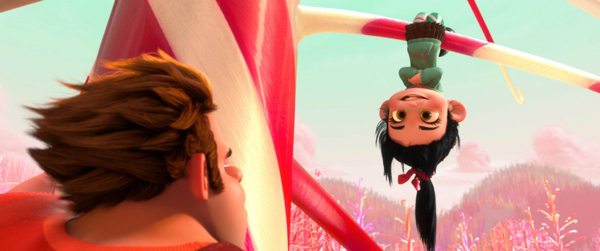Movie review by Greg Carlson
Providing a ray of hope for the future of videogame-as-movie and vice versa, Disney’s “Wreck-It Ralph” carries on the company’s once-automatic tradition of churning out art-meets-commerce product that attracts the kids but offers enough charm for the grown-ups. So much of videogame cinema is littered with the charred remains of titles that failed to bridge the appeal of play with the narrative imagination demanded by the feature film. For every movie that embraces the logic and aesthetics of videogaming there are trash heaps of the forgettable (“Prince of Persia: The Sands of Time”), the cacophonous (“Doom”), the misguided (“Street Fighter: The Legend of Chun-Li”), the balding (“Hitman”), the insensible (“Lara Croft: Tomb Raider”), and the certifiable (“Super Mario Bros.”).
And let’s not talk about Uwe Boll at all.
Of course, “Wreck-It Ralph” is not directly based on an existing franchise, so to be fair, its code more closely resembles movies in which videogame culture frames the story, including “Tron,” “WarGames,” “The Last Starfighter,” and “Scott Pilgrim vs. the World.” In “Wreck-It Ralph,” the characters that populate the graphically challenged coin-operated arcade machines of the 1980s interact with the more three-dimensionally rendered avatars representing the current state of the art. A universe is carefully constructed and presented with no small debt to the basic premise of “Toy Story.” In fact, Pixar’s influence on “Wreck-It Ralph” is so strong, one can imagine some executives wringing hands that the movie wasn’t released under that banner.
John C. Reilly lends his voice to the title character, a Donkey Kong-like heavy in the game “Fix-It Felix Jr.” Tired of being the bad guy in the Sisyphean world of re-starts and endless lives, Ralph attends a therapy group for other heels who must cope with the knowledge that medals for heroism lie forever out of reach. When Ralph decides he can take no more, he abandons his game. This grave breach, referred to by videogame cabinet inhabitants as “going turbo,” threatens “Fix-It Felix Jr.” with permanent “out of order” status. Even worse, if a character dies outside of the game to which he or she belongs, there are no more second and third chances.
Like “Who Framed Roger Rabbit?,” the rights and clearances team for “Wreck-It Ralph” surely wrote another chapter in the book covering cross-platform, competing company synergy. Cameo appearances from vintage pixel stars like Pac-Man, the Tapper bartender, Q*Bert, Sonic the Hedgehog, Bowser/King Koopa, and Zangief provide the nerdy recognition factor for older filmgoers, but the moviemakers keep the primary focus on the quartet that includes Ralph, Vanellope von Schweetz (Sarah Silverman), Felix (Jack McBrayer), and Sergeant Calhoun (Jane Lynch). A villain also emerges in Alan Tudyk’s King Candy, whose close resemblance to Ed Wynn’s Mad Hatter will endear some and infuriate others.
Silverman’s sassy, hyperactive smartmouth lives in a racing game called Sugar Rush, and her status as a “glitch,” conforms to another of Disney’s most cherished traditions: the picked-on outsider whose initially undesirable differences will be affirmed as assets en route to the lesson that everyone has value. Like many of her corporate kin, Vanellope can be anyone she wants to be and do anything she sets out to accomplish, no matter the “disability” hidden in her programming. While the outcomes for Vanellope and Ralph can be guessed by the viewer long before the retro-styled Buckner & Garcia song plays over the end credits, director Rich Moore makes the journey entertaining for gamers and non-gamers alike.
By the way, for everyone keeping track of high scores, the greatest videogame movie of all time remains “The King of Kong.”
